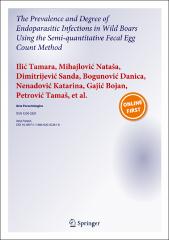| dc.contributor.author | Ilić, Tamara | |
| dc.contributor.author | Mihajlović , Nataša | |
| dc.contributor.author | Dimitrijević, Sanda | |
| dc.contributor.author | Bogunović , Danica | |
| dc.contributor.author | Nenadović , Katarina | |
| dc.contributor.author | Gajić , Bojan | |
| dc.contributor.author | Petrović, Tamaš | |
| dc.contributor.author | Despotović , Darko | |
| dc.contributor.author | Becskei , Zsolt | |
| dc.date.accessioned | 2020-08-13T10:32:25Z | |
| dc.date.available | 2020-08-13T10:32:25Z | |
| dc.date.issued | 2020 | |
| dc.identifier.issn | 1230-2821 | |
| dc.identifier.uri | https://repo.niv.ns.ac.rs/xmlui/handle/123456789/288 | |
| dc.description.abstract | Purpose Breeding of wild boars is a signifcant part of the hunting economy; however, hogs are associated with zoonotic
infection. This study assessed the prevalence and degree of parasitic infections that exist in wild boars from two hunting
grounds in the Autonomous Province of Vojvodina, Republic of Serbia.
Methods Parasitological examinations were conducted from 2016 to 2019. In total 220 fecal samples and 13 lungs were
collected from wild boars in two hunting grounds (an open and a closed habitat) on the territory of Vojvodina (Serbia).
Assessment of the prevalence and degree of the detected endoparasitosis involved a semi-quantitative fecal egg count method.
Results The presence of protozoa—Eimeria spp./Isospora spp. (76.38%; 32.26%) and Balantidium coli (7.08%), nematodes—
Ascaris suum (29.03%), Trichuris suis (31.49%; 19.35%), Hyostrongylus rubidus/Oesophagostomum spp. (55.12%; 48.39%),
Metastrongylus pudendotectus (66.14%; 21.51%), Gnathostoma hispidum (3.94%; 2.15%) and Macracanthorhynchus hirudinaceus
(9.45%; 7.53%) and trematodes—Fasciola hepatica (5.51%; 4.30%) and Dicrocoelium dendriticum (0.78%; 2.30%)
were detected as single or mixed infections, via qualitative coprological examination. The total prevalence of the endoparasitosis
was 92.91% in hunting ground I (closed habitat) and 73.12% in hunting ground II (open habitat). The most prevalent
infection in hunting ground I was coccidiosis (76.38%), and hyostrongylosis/oesophagostomosis (48.39%) in hunting ground
II. Adult forms of M. pudendotectus were identifed in the lungs of 13 wild hogs with mild to severe bronchopneumonia
from hunting ground II.
Conclusions The semi-quantitative fecal egg count method demonstrated clinical and parasitological signifcance and
revealed the risks associated with zoonotic infections in this game species population. Therefore, monitoring the etiology
and epizootiology of parasitic infections in wild boars is essential for creating health care programs in hunting ground areas
and planning control strategies that protect both the hunting economy and public health. | en_US |
| dc.description.sponsorship | This research was funded by a grant from Ministry
of Education, Science and Technological Development of the Republic
of Serbia (Project Nos. TR31084, 173001 and TR31088). | en_US |
| dc.language.iso | en | en_US |
| dc.source | Acta Parasitologica | en |
| dc.subject | Wild boar | en_US |
| dc.subject | Coprological examination | en_US |
| dc.subject | Degree of infection | en_US |
| dc.subject | Endoparasites | en_US |
| dc.subject | Health care | en_US |
| dc.subject | Hunting grounds | en_US |
| dc.title | The Prevalence and Degree of Endoparasitic Infections in Wild Boars Using the Semi‑quantitative Fecal Egg Count Method | en_US |
| dc.type | Article | en_US |
| dc.identifier.doi | 10.1007/s11686-020-00261-8 | |

